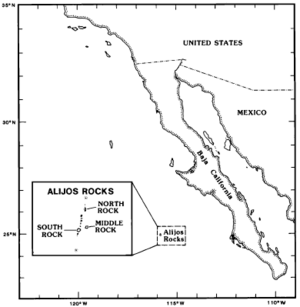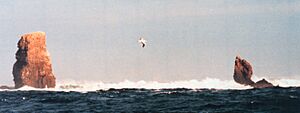Rocas Alijos facts for kids
Rocas Alijos, also known as Escollos Alijos, are a group of very small, rocky islands. They are found in the Pacific Ocean. These rocks are part of Mexico, located about 300 kilometers (186 miles) west of the mainland.
The islands are tiny, steep, and no one lives on them. They were formed by volcanoes. The total area of all the rocks together is only about 0.012 square kilometers (0.0046 square miles).
Contents
What Are Rocas Alijos?
The group has three main rocks and many smaller ones. These smaller rocks are often underwater or barely visible.
- South Rock: This is the biggest rock. It is 34 meters (112 feet) high. It is about 14 meters (46 feet) wide.
- Middle Rock: This rock is 18 meters (59 feet) high. It is about 10 meters (33 feet) wide.
- North Rock: This rock is 22 meters (72 feet) high. It is about 12 meters (39 feet) wide. It is located 200 meters (656 feet) north of South Rock.
History of the Rocks
People have known about Rocas Alijos for a long time. They appeared on a map from 1598. Some say they were officially discovered in 1605.
The first detailed description came in 1704 from a pirate named John Clipperton. A Spanish sailor made the first exact map in 1791.
South Rock was first climbed in 1990. An expedition led by Robert Schmieder reached the top. He later wrote a book about the rocks.
Why Are They Special?
Rocas Alijos are in a special spot in the ocean. It's where two big ocean areas meet. This area is also where the Pacific Current changes direction.
Because of their location, the rocks are important nesting places for many seabirds.
Mexico has two other island groups in the Pacific Ocean that are not on the continental shelf. The continental shelf is the edge of a continent that is under the ocean. These other groups are Guadalupe Island and Revillagigedo Islands.
Animals of Rocas Alijos
Many types of seabirds use Rocas Alijos as a place to lay their eggs and raise their young.
Here are some of the birds found there:
- Leach's storm-petrel: A small seabird that probably nests here.
- Red-billed tropicbird: About 14 of these birds have been seen.
- Masked booby: Around 100 of these birds live here.
- Sooty tern: About 250 of these terns nest on the rocks.
The magnificent frigatebird visits often in winter. However, it likely does not nest there. The Laysan albatross also visits Rocas Alijos every winter. It might start nesting there soon.
See also
In Spanish: Rocas Alijos para niños




